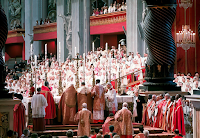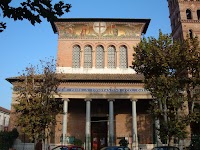 As we have noted before, the pax instrument -- also called a pax brede (board), osculatorium , or instrumentum pacis -- was a tablet that was devised in the course of the middle ages as a more sanitary means of passing the peace during liturgies -- peace that is otherwise pa…
As we have noted before, the pax instrument -- also called a pax brede (board), osculatorium , or instrumentum pacis -- was a tablet that was devised in the course of the middle ages as a more sanitary means of passing the peace during liturgies -- peace that is otherwise pa…
Our Advertising Partners
-
The global pandemic has disrupted the normal celebration of the Holy Week in Spain, where, for a second year, the government has forbidden t...
-
We live in a very visual, image-based culture and, what's more, there is always lots of curiosity around the matter of traditional papal...
-
Above is an image of Pope John XXIII after his death in 1963, dressed in red vestments for burial (the arms on the front of the chasuble app...
-
The mitre is one of the most recognizable symbols of prelates of the Church, specifically of bishops up to the Roman pontiff himself -- thou...
-
The papal blessing known as the Benedictio Coram Populo, or more commonly as the Urbi et Orbi (to the city [of Rome] and to the world) bless...
-
To the person who simply enjoys beautiful art and architecture, distinctions like "baroque" or "rococo" might seem overl...
Blog Archive
-
▼
2023
(257)
-
▼
December
(20)
- More Examples of the Pax Tablet or Pax Brede
- Papal Mantum of Pope Pius VII
- Terracotta Aumbries of Renaissance Tuscany
- A Seventeenth Century Nativity Frontal from the Wo...
- Christmas in Rome: the Chapel of the Sacra Culla (...
- St. Nicholas' Church in Ancient Myra
- The Castello della Magione di Poggibonsi: Centre o...
- A Closer Look at the Vestments of a Papal Canoniza...
- The Advent Masses of St. Kateri's Mission
- A Russian Vestment Set Made of Reindeer Fur and Ma...
- The St. Wenceslas Chasuble from the Czech Republic
- Examples of Medieval Pontifical Sandals
- Before and After: St. Monica's Catholic Church in ...
- Examples of French Gothic Revival from the First H...
- A Polychrome Marble Altar by Rugo Stone
- Marie Lemaire des Anges' 1675 Altar Frontal of the...
- The Potentiality for Modern Roman Basilica Styled ...
- A Chasuble from the Sixteenth Century
- On the Use of Tapestries at Traditional Papal Mass...
- A Violet Vestment from the Eighteenth Century
-
►
November
(22)
- Churches of Venice: Chiesa dei Gesuati (Santa Mari...
- The Chasuble and Antependium of Pizzighettone
- The Use of the Peacock in Christian Art
- Introducing Devotio- An International Exhibition o...
- Ambrosian Rite Vestments with the "Cappino" by Sac...
- Ravenna in the United Kingdom: Mosaics of the Chur...
- Hugo van der Goes in Berlin
- Before and After: St. Patrick's Catholic Church in...
- Vestments of Recusant England: The Requiem Chausub...
- Goretti Fine Art: Original Sacred Artwork for Alta...
- Splendours of Lisbon: Four Vestment Sets Produced ...
- An Impressive, Hand Illuminated Gradual and Antiph...
- Roman Vestments From the Time of Pope Pius VI
-
▼
December
(20)
Donate
Copyright ©
Liturgical Arts Journal | Powered by Blogger































.jpg)

















